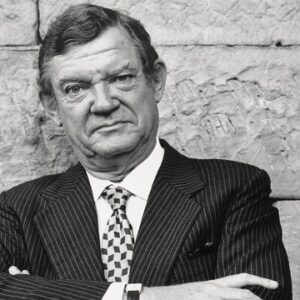Robert Studley Forrest Hughes was an art critic, author, and producer of television documentaries who was born in Australia. He was an outspokenly expressive and contentious art critic who infused his literary life with an inspirational flair he owed to artist Francisco Goya, a self-confessed artistic inspiration. He was equally well-known on television as he was in the media, having spent almost three decades in New York as the leading art critic for TIME magazine. Hughes dug into the history of major cultural revolutions in the western world, as well as the growth of society, through his incisive books and documentaries. His favorite subject has remained Australia, where he was born and raised, and he has written several volumes about the country’s aesthetic side as well as its history of British penal colonies and early European settlement. Additionally, Goya, Lucian Freud, fishing, the history of American art, the city of Barcelona, and himself were frequent subjects of his copious writings. Hughes received numerous awards for his extraordinary contributions to art, literature, and television, including the Officer of the Order of Australia and the International Emmy Award.
Childhood & Adolescence
Robert Hughes was born to Geoffrey Forrest Hughes and Margaret Eyre Sealy in Sydney on 28 July 1938. His father was a World War I pilot and a lawyer. Hughes was just 12 years old when he died of lung cancer. While he was growing up, Hughes was expected to become a lawyer as his father and grandfather both were notable lawyers. He attended Riverview’s St. Ignatius College and afterward the University of Sydney. Hughes studied art and architecture at the University of Sydney but dropped out shortly after to work as a cartoonist for the periodical ‘The Observer’. He was promoted to the position of art critic at the magazine.
Career of Robert
Hughes authored ‘The Art of Australia’ in 1966 while still working as an art critic for ‘The Observer’. He also contributed to the ‘Oz’ magazine, ‘The Nation’, and ‘the Sunday Mirror’. Simultaneously, he traveled to Europe and ultimately lived in London in 1965. He wrote for ‘The Spectator’, ‘The Daily Telegraph’, ‘The Times’, the London-based ‘Oz’, and ‘The Observer’ in London. Hughes relocated to New York in 1970 after being hired as an art critic by ‘TIME’ magazine—a move Hughes described as a shot in the dark’ for both him and the magazine.
Hughes was appointed as a commentator on ABC’s news magazine show ’20/20′ in 1978 after a successful tenure at the ‘TIME’. However, after the first tape was recorded, he was sacked and replaced by experienced television host Hugh Downs. In 1980, he co-produced the BBC’s eight-part series ‘The Shock of the New’ with German producer Reiner Moritz and Lorna Pegram. The series was based on his book of the same name; it examined the evolution of modern art. Hughes wrote his second book ‘The Fatal Shore’ in 1987 – a book that studied the history of British penal colonies and early European settlement of Australia.
The book quickly became a global bestseller. Hughes’ 1997 television series ‘American Visions’ reviewed the history of American art since the Revolution. This was followed in the 2000s by films such as ‘Australian: Beyond the Fatal Shore (2000), a series of musings on contemporary Australia, and ‘Goya: Crazy Like a Genius (2002), a documentary about Francisco Goya, his favorite artist. Toward the end of his life, he created ‘The New Shock of the New (2004)’, a one-hour update to ‘The Shock of the New’, and published the first installment of his memoir, ‘Things I didn’t Know (2006)’.
Significant Works of Robert
Hughes’ most well-known work is ‘The Shock of the New,’ which he devised in 1980 and had produced by the BBC. It examined the evolution of modern art since the Impressionists and was accompanied by a companion book of the same name.
Awards and Accomplishments
Hughes received numerous honors, including the Frank Jewett Mather Award (1982), the Golden Plate Award (1988), the Order of Australia (1991), membership in the American Academy of Arts and Sciences (1996), the Grierson Award (2009), and the International Emmy Award (2009).
Personal History and Legacies
From 1967 through 1981, Hughes was married to Danne Emerson. The pair met in London and spent the 1960s exploring counterculture, drug use, and sexual liberation together. They were blessed with a son, Danton Hughes.
He married Victoria Whistler for the second time in California. From 1981 through 1996, they were married. Hughes married Doris Downes, an American artist and art director, for the third time in 2001. The couple married and remained together till his death. He adopted Downes’ sons – Freeborn Garrettson Jewett IV and Fielder Douglas Jewett – as stepsons.
He died in 2012 at Calvary Hospital in The Bronx, New York, following a lengthy illness. Hughes was involved in a near-fatal vehicle accident in 1999 south of Broome, Western Australia. He was returning from a fishing excursion when he drove on the wrong side of the road and collided with another automobile. He spent five weeks in a coma. In 2003, he pleaded guilty to hazardous driving and received a 2,500 Australian dollar fine. Hughes’ son, sculptor Danton Hughes, committed suicide in 2002.
Estimated Net Worth
Robert Hughes earned the majority of his money selling Yeezy sneakers. While he overstated the scale of his business throughout the years, the money he earned from his occupation was genuine–enough to rank as one of the largest celebrity cashouts of all time. His primary source of income is as a professional actor, voice actor, and musician. His net worth is estimated to be between $5 and $10 million. Along with his enormous social media following, actor


